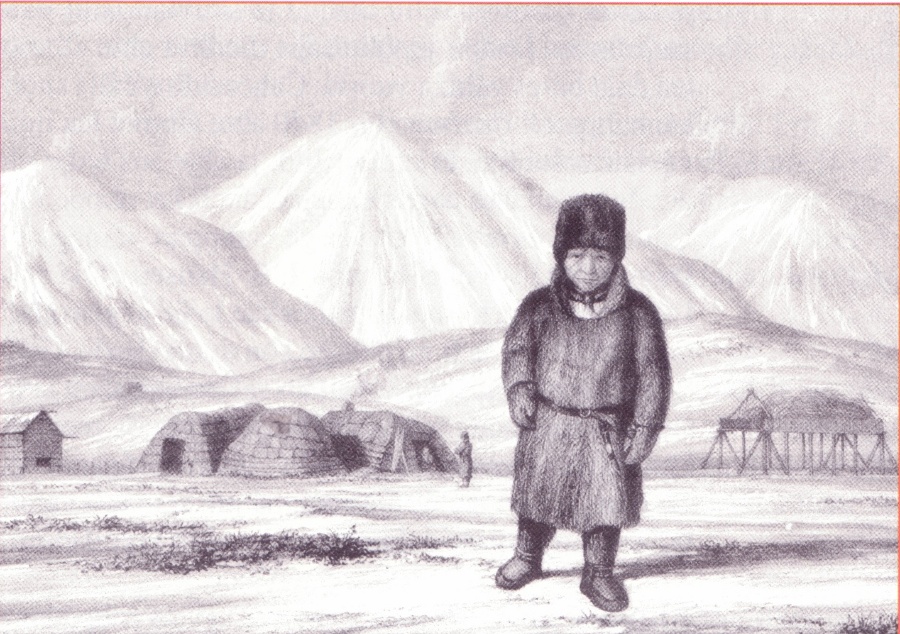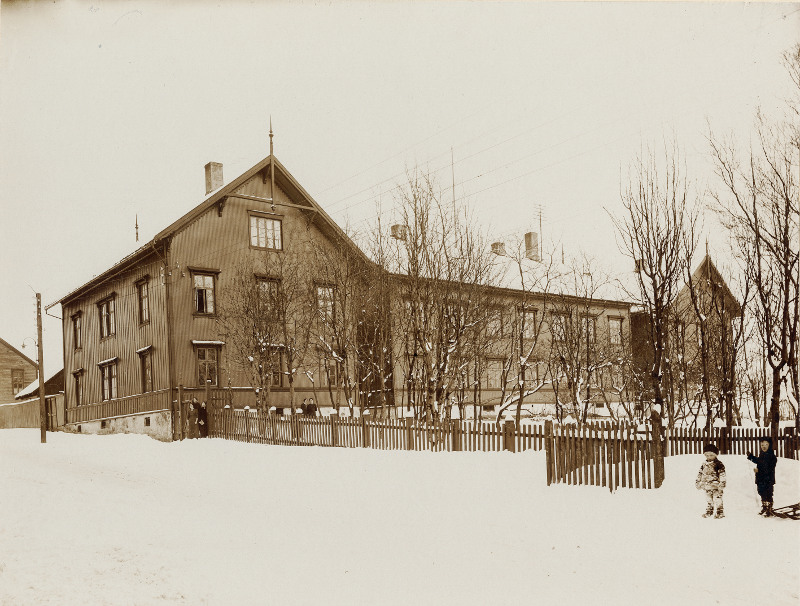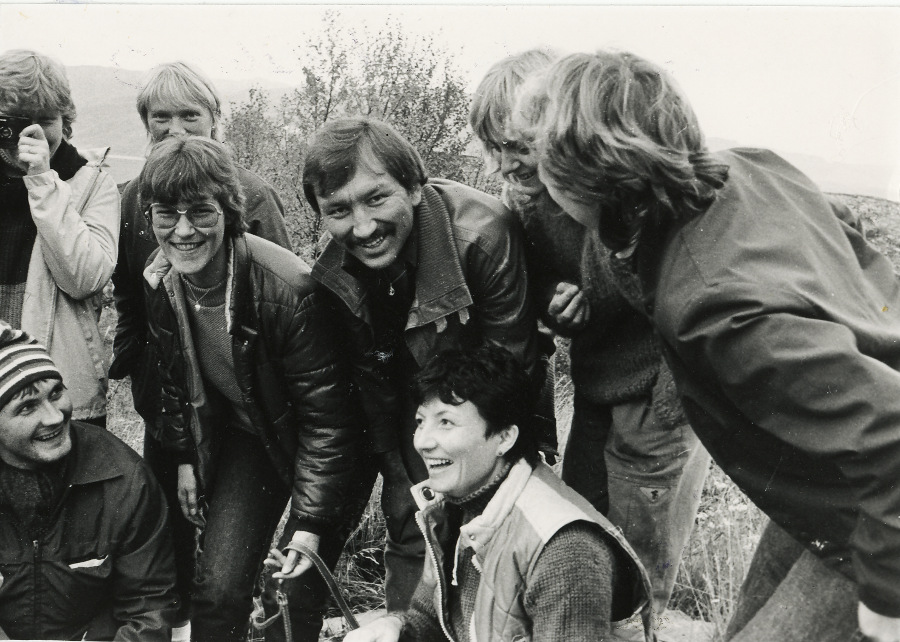 Sámegillii
Sámegillii  På norsk
På norsk
New articles for Ávvir 2013
32.– 12.10.2013
Do you know Sami school history?Here we present a series of articles printed in Sami language in the newspapers Min Áigi and Ávvir from 2007 to 2013. The basis of the articles are stories which have been collected through the project “Sami school history”. There are edited 6 books with stories and articles from school life in the Norwegian part of Sápmi. In these articles there are many quotes from the books, and we refer to the articles the quotes are taken from, to make it possible to read the entire stories there.The chief editor of Sami school history, Svein Lund, is editing this series of articles. In addition Elfrid Boine, Siri Broch Johansen and Siv Rasmussen are part of the editorial staff.
|
From the 18th century we know little about how the teaching was organized. Norwegian missionaries were taught Sami, and Sami pupils were given teacher education. Reading of religious texts has probably been important to both groups. Neither from the 19th century do we have information about how the pupils experienced the teaching. We have more or less only official sources to build on.
Among those who has done the most to sum up these is Eivind Bråstad Jensen, who in Sami school history 6 has written the article Sami in the teacher education up until 1973. We quote from his article:
The wish to strengthen the education and missionary work among the Sami in Sami language played a decisive role when the Storting passed to establish the teacher seminary in Trondenes as the first teacher seminary in the country after 1814.
The first teacher was the Sami Nils Gundersen. ... From the first year of the seminary the teaching in Sami was held in addition to the rest of the teaching, which was the same for all the students, independent of their ethnical background. This would later also apply to all Sami- and later also Finnish education at the seminary. ....
 | Nils Gundersen was teacher at Trondenes seminar 1826–40. He was the only Sami who was teacher at the seminary. (Drawing: Arthur de Capell Brooke: A winter in Lapland, 1827) |
In the 1830's the Sami pupils had increasing problems in meeting the demands of the seminary. Put differently, it seemed as if the seminary found it difficult to meet the special challenges this group of students faced it with. ... Only 14 Sami teachers graduated from the seminary during its 25 first years in service (until 1851). ...
Nils Gundersen was not only the first, but also the last Sami teacher at the seminary, ... The manager of the seminary claimed it to be more important with proficiency in theology than Sami, and cand. theol. Jakob Wetlesen, who was appointed the position, was according to the manager in 1846 still so weak in Sami language that the students were the actual Sami teachers.
In connection with the moving of the seminary from Trondenes to Tromsø in 1848 it was discussed to establish a separate teacher seminary for Sami students. But the proposal met opposition and was not followed through.
Stockfleth was a strong opponent of founding a separate Sami teaching educational establishment. To carry out the proposal would make it virtually impossible for the Sami to acquire Norwegian language, culture and civilization. Unlike the proponents he was of the opinion that the difference in the level of culture was an important argument not to divide the Sami-Norwegian seminary. Stockfleth asserted that this difference could only be cancelled through the Sami's interaction with and influence from those who had a higher level of culture.
For more than 50 years a certain number of students got scholarships at the seminary:
The arrangement with scholarships was an offer to get all the expenses of the education covered, in return for learning Sami (from 1870 Sami or Kven) and after completing the studies committing to working in a transition area for seven, later five years. Most of the time only the scholarship students were taught in Sami at Tromsø seminary. A couple of years in the middle of the 19th century bishop Juell tried to bring about that all the seminarists should learn Sami, but this was met with great opposition, and it did not last long before this demand was abolished.
From the middle of the 19th century a change in the language politics took place, and Sami had a smaller and smaller place in the school. For the teacher education this meant that one changed to wishing for Norwegian rather then Sami students. Jensen continues:
In 1857 the eight scholarship posts were divided between four Sami, three of mixed-lineage and one Norwegian student. But already the year after the eight scholarship posts were divided between five Norwegians, two Sami and one Kven student. This was due to a change in the regulations which in reality gave the top priority for the posts to Norwegian students. ... It was sufficient for a teacher to know enough Sami to be able to translate Norwegian words and expressions for the children if they did not undertand. Sami was only to be used occasionally and to a smaller extent. ... Only one Sami got a scholarship post in the period 1859-66.
In the period 1863–70 there was a separate teachers college in Alta, and in this period the teaching of Sami and Kven language was moved there. ... The moving of the Sami teaching to Alta meant that the old wish to split the teacher education for Norwegians and Sami more or less had been fulfilled. ...
With the prevailing minority-political climate there was no surprise that Altens teachers college after running a short time was criticized because the teachers who graduated did not have satisfactory Norwegian skills. ... In the perspective of Finnmark the short time with the teacher education in Alta gave the county many new teachers, most of them with Sami and/or Kven background. But viewed from the norwegianizing perspective the teachers college in Alta must be seen as a failure, as most of the teachers who graduated were poor tools for norwegianizing, as they mastered the language of teaching in the school rather poorly. ...
 | Tromsø seminary around 1900. Seminary buildings were ready built in 1865. (Photo: Perspektivet museum) |
The 13th of December 1904 the Storting passed that the arrangement with scholarships at Tromsø seminary should come to an end. The last 6 students in Sami graduated in 1905 and in 1906 the last 3 students graduated with an exam in Kven.
(All quotes until now: Eivind Bråstad Jensen – SSH6)
At the time it was in principal passed to take up again the teaching in Sami in Tromsø teachers college. But nothing was prepared when we started, we had to demand it ourselves. We were 6-7 Sami speaking students at the school. The headmaster called us one by one to his office and asked: Do you wish to study Sami? The first ones who went to his office said they did not wish to study Sami, it would be more work. But I said that I absolutely wished to study Sami, and the ones who came after me wanted that as well, and so it was. And when the Sami teaching got started, the ones who had not wished to study Sami also participated. For two years we learned Sami, a few hours a week. ...
There were no textbooks, mostly stencils. We also read in the Bible, but the Bible had a different spelling than the one we were supposed to use, the so-called Bergsland–Ruong, which was quite new at the time. There were no dictionaries either. In the end we did both an oral and a written exam. Most of the students studying Sami had Sami as their mother tongue. There were also a few of Norwegian mother tongue who began the course, but they gave up early, it turned out to be far too difficult for them.
(Ellen Turi Guttormsen, student at Tromsø teachers college from 1954 – SSH3)
 | Sami students in Alta: On the rock carvings field a September day in 1983, Half year unit students of Sami language and culture. Behind, from the left: Else Grete Rasmussen (Broderstad), Berit Ranveig Iversen (Nilssen), In front: Asbjørn Guttorm, Anne Olli. In the middle: Ellen Johnsen, Johan Mathis Hætta, Reidun Aslaksen, Anne Kirsten Holmestrand. (Photo: Odd Mathis Hætta) |
In the teachers college we had the Sami lessons in the 0. lesson, before the others started their school day. The Sami teacher was the priest Asbjørn Flokkmann. I can not say he spoke Sami very well, but he knew the grammar and the rules for the orthography. And that was what we needed, we already knew how to speak Sami.
(Hans J. Eriksen, student at Tromsø teachers college from 1955 – SSH6)
When the teachers college in Alta was established in 1973 it was emphasised that the eduction should be adapted to remote areas and areas with Sami language. The situation for the Sami students was very difficult the first year. The autumn 1973 the only offer in Sami language was two hours of teaching a week. It was Håkon Henriksen (who did not have any formal qualifications in Sami) who was in charge of the teaching, together with the students Máret Sárá and Inga Ravna Eira, who both had completed basic university courses in Sami in Oslo. ...
Little by little there were developed many courses where the teaching was done in Sami and the content was Sami language, culture and history. In 1974 the quarter year unit in the general teacher training programme was developed, in 1975 the half year unit and in 1976 the full year unit/ further education. ... The employees were under a great pressure. Simultaneously they were supposed to develop curriculums based on insufficient literature, qualify for a higher academic degree and be pioneers in the teaching of Sami students.
(Jostein Hansen, teacher at the teachers college in Alta from 1974 – SSH6)
During the 16 years the Sami teachers education was placed in Alta there was a lot of discontent among the teacher and the students, and a lot of struggle with the college board. In the end the Sami teachers education was separated and moved to Kautokeino, where it became the core of the development of the Sami college.
The Sami perspective was attended to in all the subjects, and I experienced it as very good to be taught in Sami, although a lot of the textbooks were in Norwegian. ICT and traditional Sami knowledge was a part of all subjects and practices. ... In pedagogics we discussed a lot about what and how Sami pedagogics are. ... The basis for the teaching was Sami areas, ways and conditions of living. .... Overall the teachers education had a solid Sami perspective, both in the subjects and the projects.
(Sara Ellen J. Eira Heahttá, teacher student at the Sami college from 2001 – SSH6)